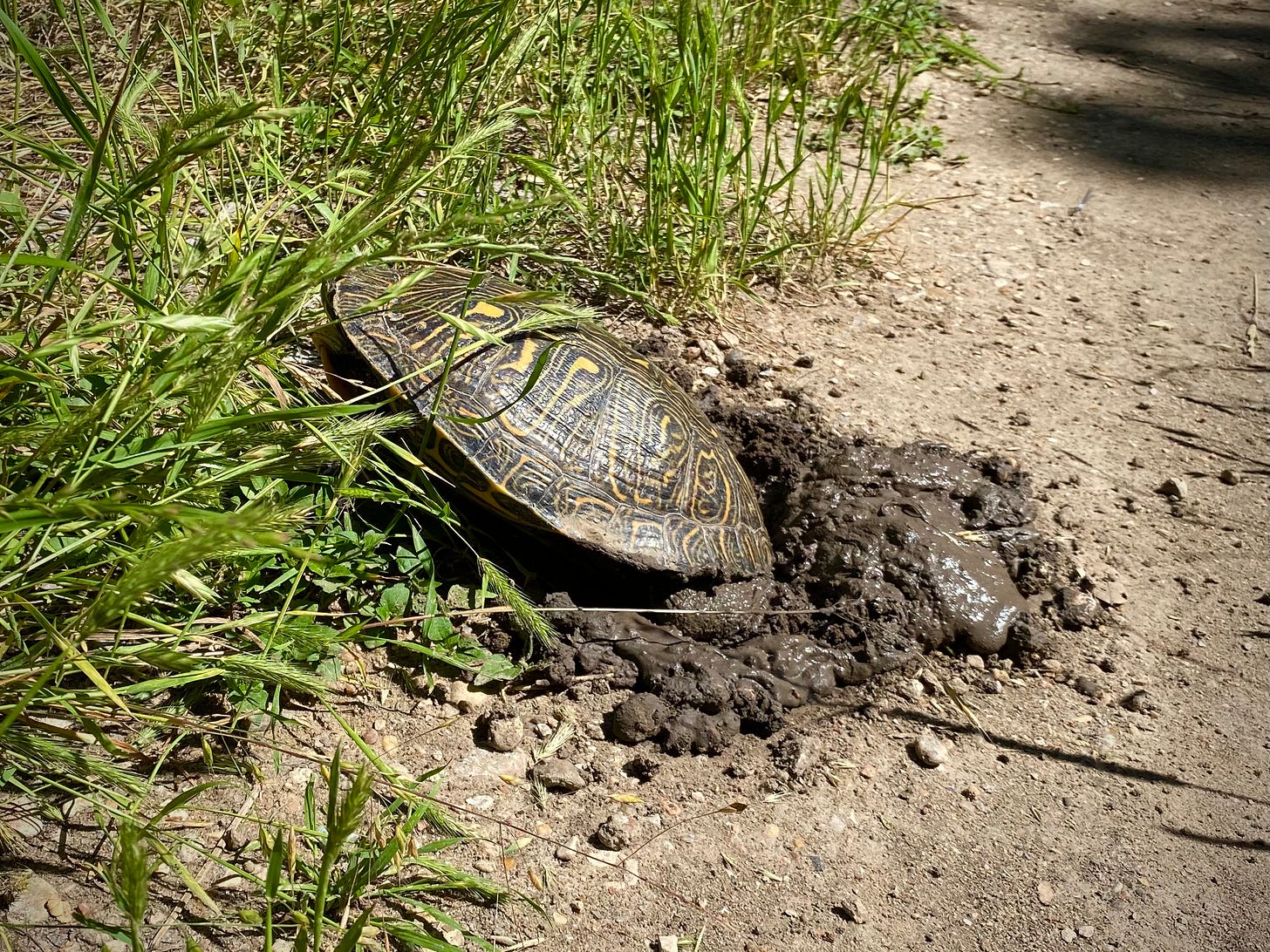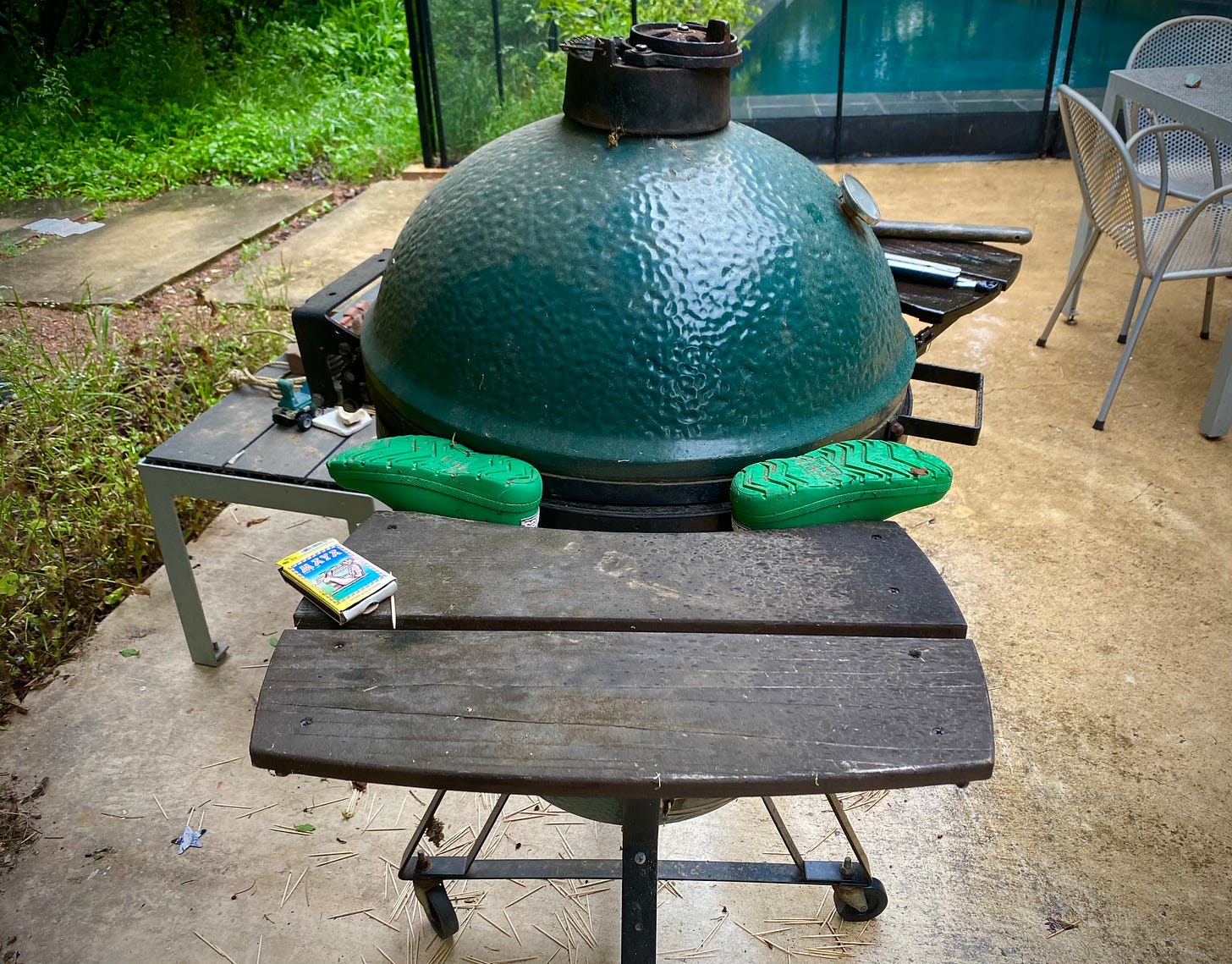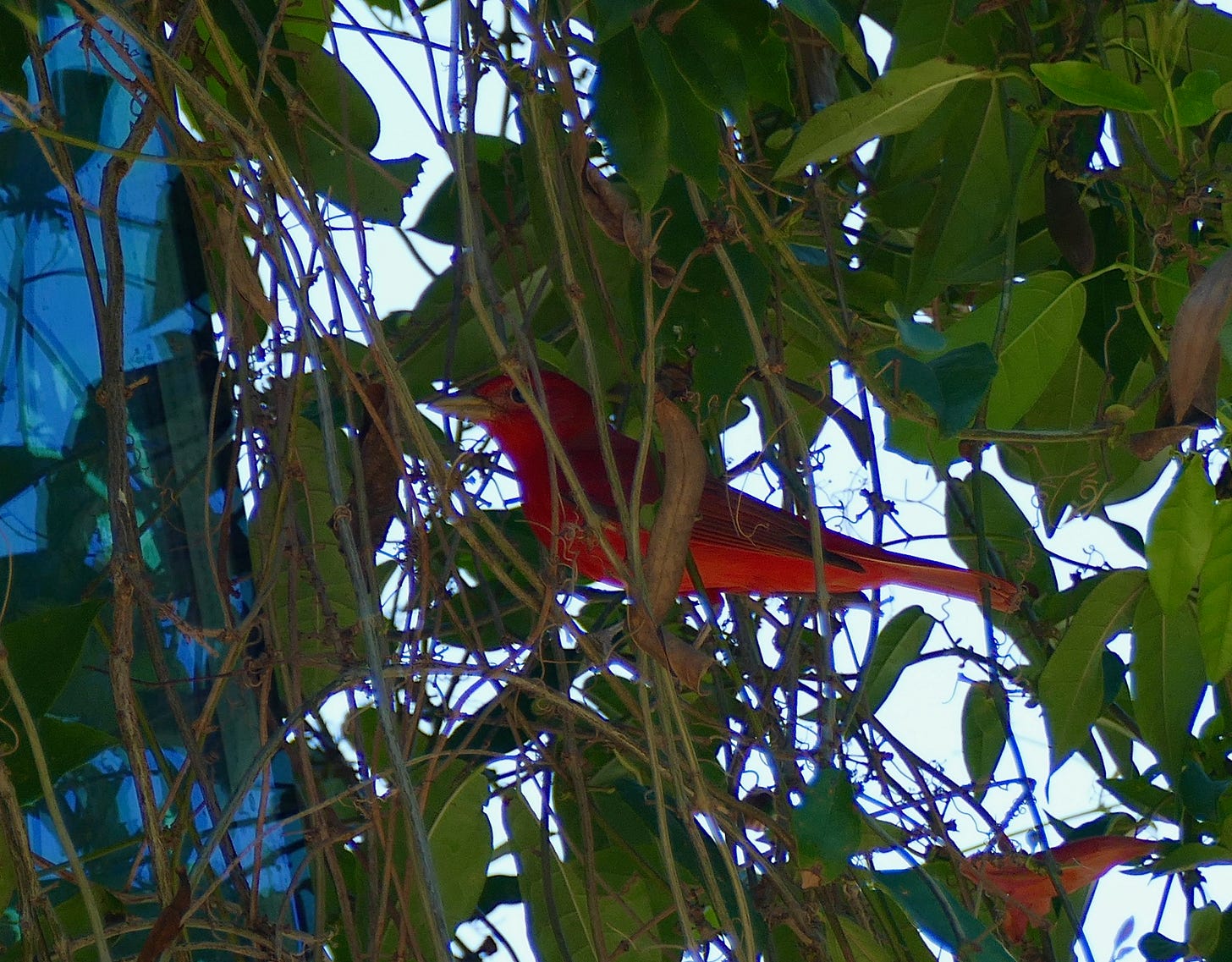May Day in the American edgelands
Last Sunday my daughter and I set out for a long walk along the urban river. She embraces the outdoors with precocious gusto, discovering the simple wonders of flowers and animals and rocks to be thrown into the water. On this excursion, with her rain boots and tiny hiking pants, she discovered the joys of stomping in the shallows, and of watching schools of tiny fish. We walked close to a mile downriver to where you can watch the planes come in over the spot where the river widens and the waterfowl gather in the shadow of the old bridge, and both earned a long nap. It will soon be too hot to undertake such an excursion after 9 a.m., but for now the temperature is just right, and the world around us is green, charged with the juice of spring rain.
We followed the path of a couple of deer through the sand in a little side channel, putting our fingers into the tracks of their big toes, down to the wetland where that shipwrecked Impala used to come and go with the rise and fall of the waters, and then clambered up the eroding bank of the old gravel pit turned involuntary nature preserve. The dirt trail there is full of little chunks of trash, bits of tile and brick from demolished buildings, and along one side is a cactus garden grown up amid big curvaceous forms of concrete spilled out onto the land by the mixers decades ago. And there, in the middle of the trail, a mama slider was laying her eggs.
I see the eggs all the time here in the zone around the river, usually after they have been dug up for food by raccoons. That’s probably the reason gestating terrapins can often be found surprisingly far from the water, in the field behind the door factory or even in the middle of the road, looking for a spot where their buried babies will make it at least to hatching without being devoured. Every year this time I have to save one from our barking dogs, and set it outside the fence back in the woods. Less often, we find the babies working their way to the water.
It was remarkable to see how that creature managed to make its own mud from that dry dirt, and I wondered whether she somehow carried it with her. It must have been right in the moment of laying that we came upon her, walking by just slowly enough to take in the scene and try to explain it to my daughter as we passed, the look on her face a mix of fascination and instinctive wariness.
As we walked on toward home, following the trail down into the woods behind the dairy plant, I got to thinking about what kind of world my daughter will emerge into. Maybe the harsh Texas climate will prove a good training ground for a warmer world. Later in the week I got a laugh when I noticed how my wife had stowed baby’s water-filled boots after I returned her home wet and dirty and smiling—tucked into the backyard grill in the same way the dudes stow their rubber work boots into the gap between the bed and the cab of their pickups.
Later that afternoon, a fidgety rustle in the cross vines that hang from our roof revealed the return of another herald of summer: a bright red tanager flitting from vine to vine, eating whatever little bugs follow those infinite intertwining stalks. This time last year what may have been the same male arrived, right around May Day, but in different colors, the orange and yellow the dudes of that species display their first season out looking for love and adventure. This year, as the landlords get to work effacing the slogans of the East Austin Maoists from the sides of old industrial buildings being prepared for redevelopment or demolition, I was struck by how the mature male summer tanagers show up for May Day dressed for that holiday’s twentieth century variation. Tag der Arbeit, according to the German desk calendar I use.
May Day is a holiday that has never really found its way onto the American calendar. The proletarian variant never had a chance in a country founded on the idea of being the owner, and the adoration of labor as a humble virtue in service of the divine plan. The pagan variation, whose blissful persistence in English culture I experienced as a college student abroad, briefly flourished on these shores, only to be quickly extinguished by the Puritan fathers of Massachusetts.
Hawthorne wrote a story about it, “The May Pole of Merry Mount,” but I first learned about it in a book I bought at a science fiction convention that happened to be held right down the road from the part of Quincy, Mass. that was known to the natives as Passonagessit, colonized as Mount Wollaston after the captain of the first English ship chartered to settle it, and then renamed Ma-re Mount around the time said captain took off after a year for better opportunities in Virginia, leaving behind Thomas Morton and the indentured servants they had brought with them on the boat. Morton had a different conception of his faith than the Pilgrims. As the story goes, when left in charge of the settlement, he freed the servants from their indentures, befriended the Indians, and began a more libertine utopian experiment on the coastal bay he saw as a paradise.
On May Day, 1627, Morton and his colonial and indigenous compatriots erected an eighty-foot Maypole garlanded with flowers and crowned with the antlers of a buck, and used it as a beacon to invite revelers by land or sea to a party so wild it got the whole settlement shut down. You can read Morton’s version of the story in the memoir he wrote of his time there, which includes his recollection of the Wicker Man-worthy song they sang as they poured down the beer they had brewed and the spirits they had carried over, and got the natives to join them in the dance:
About the merry Maypole take Roome. Make greene garlons, bring bottles out And fill sweet Nectar freely about. Vncover thy head and feare no harme For hers good liquor to keepe it warme.
Then drinke and be merry, &c. Iô to Hymen, &c…
Give to the Nymphe thats free from scorne No Irish stuff nor Scotch over worne. Lasses in beaver coats come away, Yee shall be welcome to us night and day.
Writing after he returned to England, Morton goes on with evident pride at how much the event provoked the prudish ire of his neighbors at Plymouth Plantation, who he dubbed “the Separatists,” currying the favor of a royalist audience. Sympathetic modern histories contend Merry Mount under Morton became a refuge for oppressed peoples and nonconformists—“Indians, the discontented, gay people, runaway servants, and what the governor called ‘all the scum of the country,’” according to Peter Linebaugh’s compelling history of the holiday. The other version of the story can be found in William Bradford’s On Plymouth Plantation, anticipating Lovecraft:
They allso set up a May-pole, drinking and dancing aboute it many days togeather, inviting the Indean women, for their consorts, dancing and frisking togither, (like so many fairies, or furies rather,) and worse practises. As if they had anew revived & celebrated the feasts of ye Roman Goddes Flora, or ye beasly practieses of ye madd Bacchinalians. Morton likwise (to shew his poetrie) composed sundry rimes & verses, some tending to lasciviousnes, and others to ye detraction & scandall of some persons, which he affixed to this idle or idoll May-polle. They chainged allso the name of their place, and in stead of calling it Mounte Wollaston, they call it Merie-mounte, as if this joylity would have lasted ever. But this continued not long, for after Morton was sent for England, (as follows to be declared,) shortly after came over that worthy gentlman…who visiting those parts caused yt May-polle to be cutt downe, and rebuked them for their profannes, and admonished them to looke ther should be better walking; so they now, or others, changed ye name of their place againe, and called it Mounte-Dagon.
Myles Standish was the one dispatched at the head of the Plymouth Militia to cut down the Maypole and shut down the sinful dissidents of “Mount Dagon.” And when you read further into Bradford’s history, you learn the thing that most upset them about Morton was that he was giving the Algonquins guns.
The truth of what went on in Ma-re Mount is probably not as noble as the utopians would like us to believe, but it does give an interesting prism through which to imagine alternate scenarios for how the European settlement of this continent might have played out, and what a different kind of occasion Thanksgiving could have become.
Reading more deeply on the story of the first and last American May Day gets me thinking that the pagan spring fever and radical syndicalist versions of the holiday are more in sync than I previously assumed. Those indentured servants that came over with Morton and Wollaston and so many of the other colonial expeditions to the Americas are a clue. The idea of nature embodied in the Maypole is one that precedes agriculture, an acknowledgement of the feral part of human nature, a hunting, foraging, and free-loving nature to which the idea of labor, as conceived by the institutional powers that preside over farm fields and factories, indenturing the world to the generation and hoarding of surplus, is utterly alien.
One wonders what fresh variation the 21st century might yet conjure, in the heavy weather stress of our looming crisis. And whether it would produce an equally swift response from the state the Puritans germinated on this soil.
Rewilding Reading List
For a longer (but still short) recount of the history of Thomas Morton and Merry Mount, check out this piece by Matthew Taub at Atlas Obscura.
You can read the full text of Morton’s New English Canaan over at Project Gutenberg, or in a facsimile of the original at Google Books.
Bradford’s On Plymouth Plantation is also at Project Gutenberg, and the history of “Mount Dagon” and the “Lord of Misrule” can be found in his discussion of the year 1628.
On the topic of green futures, EuroNews has an interesting article on how organized the movement has gotten to try to turn Scotland into the world’s first “rewilded nation.”
And for those interested in the auditory experience of urban nature, University of Texas anthropology professor and improvisational musician Marina Peterson has edited a fascinating new issue of Sensate Journal on the theme of “Sounds of the Anthropocene.” Peterson’s new book in a similar vein, Atmospheric Noise: The Indefinite Urbanism of Los Angeles, is on my TBR pile.
Reunited and it feels so good
My son and daughter-in-law returned to Texas briefly this week, after we had been separated by the Pacific Ocean and the quarantines of two nations since January 2020, and it was good to see them. They are artists who met as undergraduates at RISD, and one morning Ajin captured the image of her toddler sister-in-law and me as we returned from another of our morning wanders in the urban woods. I really love this drawing, not just because it allows me to share a personal image without violating my rules against selfies and posting pictures of my children online.
Closed for renovations
Field Notes will be off next week, and may have a few days of downtime as I work on some platform changes to what has proved a surprisingly popular experiment. Thanks for reading, and have a safe and enjoyable couple of weeks.
To hold you over, here’s the tanager as he appeared last summer:












https://www.waldorfpublications.org/blogs/book-news/21208897-may-day-in-the-waldorf-school - Steiner in turn influenced by Rosicrucian and other mystical movements attempting to revive pagan, non-christian ritual practices. Morton from wikipedia: Thomas Morton was born in Devon in 1579, into a conservative Anglican family belonging to the landed gentry. Devon at that time was seen as the "dark corner of the land" by Protestant reformers, for its traditionalist intransigence, which included not only a High Church Anglicanism that shared many traits with Catholicism, but a paternalistic populism combined with rural folk tradition that to the Puritans seemed close to paganism. To locals, however, it was merely "Old England"—a culture firmly ingrained in them.
Good luck with the transition to a new platform.